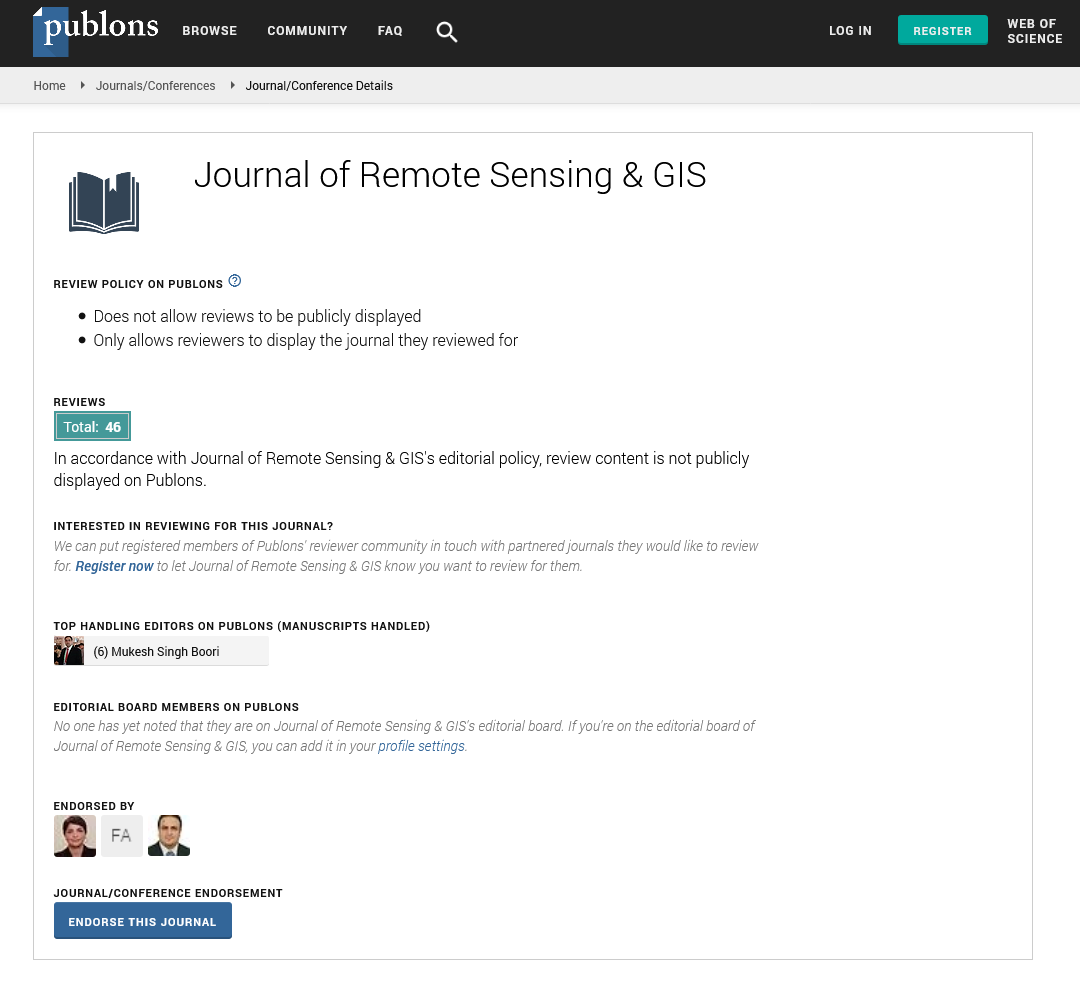Indexed In
- Open J Gate
- RefSeek
- Hamdard University
- EBSCO A-Z
- OCLC- WorldCat
- Publons
- International Scientific Indexing
- Euro Pub
- Google Scholar
Useful Links
Share This Page
Journal Flyer

Open Access Journals
- Agri and Aquaculture
- Biochemistry
- Bioinformatics & Systems Biology
- Business & Management
- Chemistry
- Clinical Sciences
- Engineering
- Food & Nutrition
- General Science
- Genetics & Molecular Biology
- Immunology & Microbiology
- Medical Sciences
- Neuroscience & Psychology
- Nursing & Health Care
- Pharmaceutical Sciences
Commentary - (2023) Volume 12, Issue 1
A Brief Summary on Remote Sensing of Polar Regions
Samer Hattar*Received: 02-Jan-2023, Manuscript No. JGRS-23-19887; Editor assigned: 04-Jan-2023, Pre QC No. JGRS-23-19887; Reviewed: 18-Jan-2023, QC No. JGRS-23-19887; Revised: 23-Jan-2023, Manuscript No. JGRS-23-19887; Published: 03-Feb-2023, DOI: 10.35248/2469-4134.23.12.274
Description
The Earth is a vibrant system that continuously undergoes spatio-temporal changes induced by natural and anthropogenic forces. These changes are profound in the polar regions, making these regions predominantly appropriate to understand processes operating in the Earth system. The polar regions have homogenously shown the first distinctive evidence of anthropogenic activity on Earth’s atmosphere and climate in past two decades. The polar regions are isolated and often inaccessible due to their remote geographical location. Field campaigns of the whole polar region are very difficult, if not impractical. Satellite remote sensing provides a cost-effective means to acquire synoptic coverage of the polar regions from space. Because of satellite remote sensing data and methods, it is now feasible to study the high latitude regions in a manner that was implausible even a few decades ago. The remoteness of the Earth’s polar regions has stimulated polar researchers to exploit satellite remote sensing, as either a principal or ancillary research tool, for several years. Very High Resolution (VHR) and High Resolution (HR) remote sensing imagery is used in cryospheric research since its inception, even though particular remote sensing sensors were not exclusively developed for polar research. This serendipitous use of remote sensing in cryospheric research continues with remote sensing sensors such as scatterometers to track the melt season of the greenland ice sheet.
In addition to such adaptations, some of the earliest Earth science missions of National Aeronautics and Space Administration (NASA) carried polar orbiting platforms, an example being the Scanning Multichannel Microwave Radiometer (SMMR) aboard Nimbus-7 that yielded a dataset for the period of 1978-87. The success of SMMR paved the way for many more the passive and active microwave sensors dedicated to sea ice observations. In addition to dedicated satellite instruments and programs that have monitored critical manifestations of climate change, such as the retreat of Arctic sea ice, enhanced motion of the Antarctica ice sheets and the evolution of the ozone hole in both polar regions, many serendipitous applications of satellite remote sensing are being undertaken for polar research. A survey of polar remote sensing accomplishments is particularly useful at this point in time, as the Earth science community is experiencing a transition to a new generation of satellite Remote Sensing (RS) instruments with an order of magnitude greater capability than their predecessors. Space-borne and air-borne RS has proved to be very useful in the scientific exploration and environmental protection of the Arctic and Antarctic, e.g., ice sheet movement, carbon flux and changes in vegetation are of global significance. Climate change and its impact on polar regions is a most important theme in the Arctic and Antarctic research programs.
Remote sensing, also called Earth observation (EO), is broadly defined as “the art, science, and technology of obtaining reliable geo-information about geographical/physical objects and the environment, via recording, measuring and interpreting imagery and digital depiction of energy patterns derived from noncontact sensor systems”. RS uses specific regions or numerous regions of the Electro Magnetic Radiation (EMR) spectrum to acquire data. RS system record the EMR energy reflected or emitted by the Earth’s surface. In particular, in this dissertation, we take into account the use of RS images collected by sensors aboard air or space-borne platforms for observing and characterizing the Earth's cryospheric surface. These RS sensors records the EMR energy reflected or emitted by the Earth’s surface to create an image of the landscape beneath the platform.
Conclusion
Depending on the source of the energy involved in the image acquisition, RS imaging systems can be distinguished in two categories: 1) passive systems and 2) active systems. Passive systems rely on the presence of an external illumination source, i.e., the sun. The signal measured by the sensor. The radiation coming from the sun, that is reflected by the Earth surface and passing through the atmosphere to reach the sensor and the energy emitted by the Earth itself, because of its own temperature. The EMR energy captured by the sensor is typically composed of several spectral channels/bands and over a certain elementary area.
Citation: Hattar S (2023) A Brief Summary on Remote Sensing of Polar Regions. J Remote Sens GIS. 12:274.
Copyright: © 2023 Hattar S. This is an open-access article distributed under the terms of the Creative Commons Attribution License, which permits unrestricted use, distribution, and reproduction in any medium, provided the original author and source are credited.

